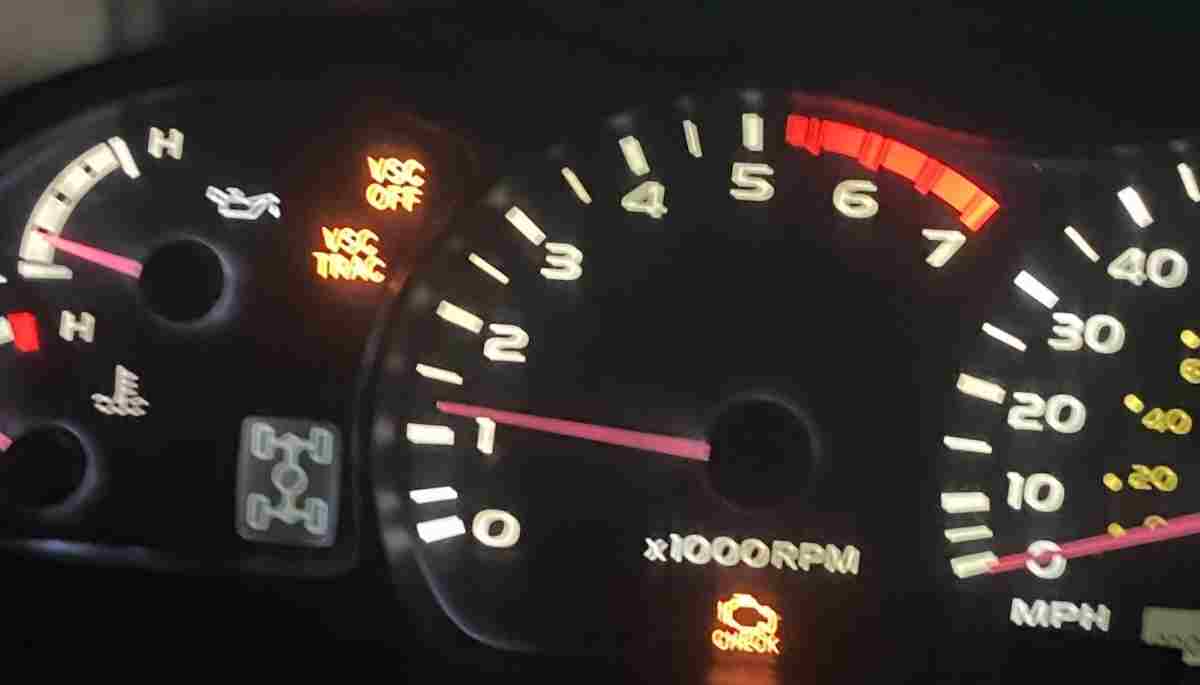Need to know about the VSC light on Toyota? Notwithstanding whether you purchased a car newly or not, every car deserves regular maintenance.
You may have had a little disappointment when you spotted a light on your instrument panel flashing while you were driving and wondered what it was and why it was doing so quickly.
Not to worry because this guide addresses all of your questions about the VSC light on Toyota, including what it means, whether is it safe to drive with the VSC light on Toyota, what causes VSC problems in Toyotas, and so much more.
What does the VSC light Toyota mean?
Vehicle Stability Control is known as VSC. In actuality, it lessens the likelihood that your car may slide or skid.

It comes standard in Toyota cars and is very helpful for maintaining traction and controlling stability by completely cutting off power to the wheels; it applies brakes to all of the wheels at once to manage your car, particularly in the rain or snow.
This device enables the driver to control the vehicle during skids and make quick cutbacks in an emergency.
Why does the VSC light On Toyota comes on?
You may be wondering what causes VSC light problems and what you can do to rectify them. The presence of a VSC light indicates a malfunction with the vehicle’s traction control. Most often, a little light on your instrument panel near the steering will illuminate when there is an issue with the O2 sensor or gas cap, alerting you that something is wrong.
When you tighten the gas cap, the VSC light on Toyota can be fixed, or you can just replace it, but sometimes the issue is with something else. It is suggested that you send your car for a thorough checkup at an auto shop so that specialists may diagnose the issue by scanning codes, but you must make sure that you have taken all essential procedures to identify the issue before you bring your car in for the inspection.
When there are traction-related problems, your dashboard’s VSC warning light will turn on. Although everything we would describe here is rather technical, we would break it down with illustrations so you and your technician could tackle the problem together.
Therefore, the steering angle sensor beneath the steering wheel neck may malfunction. A malfunctioning Speed sensor that is situated near the wheel caliper region may be to blame. When you notice a VSC light on, it’s crucial to have your technician examine the VSC and ABS components since a malfunctioning steering rack might potentially be the issue.
Sometimes the requirement for reprogramming is the reason the light turns on. You don’t need to work too hard to figure out how to tackle this straightforward issue. The engine trouble code, or “C1201,” is the one that often appears with the VSC light. Make sure your technician scans the car without clearing the error code. Toyota’s official website may have further info on the VSC.
Is it safe to drive with VSC light on Toyota?
As mentioned previously, VSC is a built-in function that aids in controlling the vehicle’s shocks and brakes in case of an emergency.
When the computer detects a problem, a light flashes, telling you to get your car examined. The actual issue is whether it is safe to continue operating the vehicle with the VSC light on Toyota.
The VSC light might glow for a variety of reasons. It is safe to drive, but not for a long time since the car would not be obtaining the proper gas mileage if the O2 sensor had a problem.
The O2 sensors can be repaired without a degree; however, depending on your Toyota model, they may or may not be simple to replace. Some of the replacements required going underneath the car, while others could be done from the inside.
It is best to take your car to a repair shop if the light comes on since they have a plug that scans codes and can then identify the issue your car is having.
When should you use the VSC off button?
Sometimes when you drive irresponsibly, you merely end up getting your car stuck in mud or snow. To pull your car out of the mud or snow, the driver has to activate both the TRAC and VSC systems.
When your car becomes stuck, the traction control system, or TRAC, is employed to free it. If you want to switch the TRAC back on, just click the VSC OFF button once more. You may turn off the TRAC by pushing and releasing the button.
The TRAC OFF indication lights turn on when the TRAC is turned off. The indications for TRAC OFF and VSC OFF will be shown if you hold the button down for a short period—roughly three seconds—to switch off both the TRAC and the VSC. By pressing the button once again, you may activate both in the same manner.
You can also switch them on by shutting off your engine; when you resume it, the TRAC and VSC lights will both be on.
How to fix VSC light on Toyota
Now, you need to follow a few procedures to repair your VSC light at home if it is damaged or not functioning. The VSC button is situated next to the steering wheel; the exact placement might vary somewhat depending on the model.
- Once you have located the button, pull over; it’s preferable to park.
- You must push and hold that button for a short period.
- When both the TRAC OFF and VSC OFF indications light up, both systems have been switched off.
- Now that the systems have re-engaged, pushing the button once again will turn on both of them and turn the light off.
When the VSC OFF light doesn’t turn off as expected and is still visible, there may be a problem with your system. Bring it to your local Toyota repair shop; it is always advisable to have qualified specialists for your car; they will find the problem and fix it.
Driving when the VSC OFF light is still on is not particularly hazardous, but it is equally risky in bad weather.
How to reset the VSC light on Toyota?
You can reset the dashboard light on your car by using the instructions below.
- The very first thing you should do is start the engine of your car and put the brakes on to prevent it from moving while you are working.
- The next step is to work beneath the hood; this is preferable since in certain circumstances, working below the car is also necessary. You must raise the hood of the car and carefully inspect the engine. You must search for the air filter box in black that is connected to the left side of the engine. It has a square form and a large intake hose with ribs.
- Check all of the vacuum lines, which should be precise and be tiny and black, and located around the air filter box. In case there are any disconnected lines, reconnect them. Tighten the vacuum lines if any of them are loose.
- Now that the hood is closed, you can now return to your car, start the engine, and do a test drive to determine whether the VSC warning light has vanished from the dashboard.
- Once again, switch off the engine, put the parking brakes on, and then park the car. Now you must reopen the hood and, using the appropriate-sized socket, unplug the battery negative cable for around 20 seconds.
This kind of negative battery cable separation helps to restart the car’s computer, which in turn turns off the VSC warning light on your dashboard.
Summary
Vehicle Stability Control is an electrical system that keeps the vehicle stable and aids the driver in maintaining control of the vehicle in difficult and emergencies.
It cannot be replaced by safe driving techniques and is not suited for routine usage. Factors such as road conditions, weather, speed, and the like are what affect VSC. They indicate whether or not VSC is capable of preventing and lessening the loss of control.
In the above guide, we explained the meaning of VSC light on Toyota, if it is safe to drive with the VSC light on, and what causes VSC problems.


